K.M. Alexander's Blog, page 7
December 30, 2022
My Reading List for 2022
On the whole, I didn’t enjoy 2022, it had some wonderful moments, but overall it’s been a challenging year. One bright spot—as it always is—has been my reading. Still, it took me until this last week in December to surpass my goal of forty-two novels ending the year with a solid forty-four books read. That’s three and a half books a month, a decent number for a reader as slow as myself. I primarily focused on novels and a few novellas. Like last year, you won’t find many comics or short stories below, but I did read some, and they are listed out though I won’t be naming a favorite in either category.
As it does every year, this list correlates with my Goodreads 2022 Reading Challenge. Occasionally, you might find some slight differences between the two. (Not this year.) This list is all strictly reading for pleasure—I typically forgo listing any research/history books I’ve read for a project as I read those differently than I do fiction. This list is always enormous, so l skip reviews except for the standouts. However, I’d invite you to follow me on Goodreads, where I occasionally leave other reviews.
Most links will go to IndieBound—now more than ever, be sure to support your local bookstore. If possible, I am directly linking to each author’s website—if you’re on the list and I didn’t find your website, please let me know about it. (I won’t link to social media, sorry.)
 Novels & Novellas
Nemesis Games
(The Expanse #5)
Novels & Novellas
Nemesis Games
(The Expanse #5)by James S. A. Corey The Bright Ages
by Matthew Gabriele & David M. Perry Storm of Locust (The Sixth World #2)
by Rebecca Roanhorse Crossroads
by Laurel Hightower High-Rise
by J. G. Ballard The Wicked Blade
by Jason Vanhee Between Two Fires
by Christopher Buehlman Piranesi
by Susanna Clarke Rise of the Mages (Age of Ire #1)
by Scott Drakeford The Power Broker: Robert Moses and the Fall of New York
by Robert A. Caro The Final Girl Support Group
by Grady Hendrix Quicksilver (The Baroque Cycle #1)
by Neal Stephenson Shorefall (The Founders Trilogy #2)
by Robert Jackson Bennett Rivers Of Power: How A Natural Force Raised Kingdoms, Destroyed Civilizations, And Shapes Our World
by Lawrence C. Smith, PhD. Sphere
by Michael Crichton Mexican Gothic
by Silvia Moreno-Garcia The Forever Sea (Tales of the Forever Sea #1)
by Joshua Phillip Johnson Bone White
by Ronald Malfi Dead Silence
by S.A. Barnes The Civil War, Vol. 2: Fredericksburg to Meridian
by Shelby Foote The Shadow of the Torturer
by Gene Wolfe Centennial: A Novel
by James A. Michener Parable of the Sower (Earthseed #1)
by Octavia Butler Three Moments of an Explosion
by China Miéville Billy Summers
by Stephen King The Hollow Places
by T. Kingfisher Tigana …again
by Guy Gavriel Kay The Thirteenth Hour (The Cruel Gods #1)
by Trudie Skies The Devil Takes You Home
by Gabino Iglesias Clown in a Cornfield
by Adam Cesare Shōgun
by James Clavell The Cooking Gene: A Journey Through African American Culinary History in the Old South
by Michael W. Twitty Sandman Slim (Sandman Slim #1) …again
by Richard Kadrey The Book of Koli (Rampart Trilogy #1)
by M. R. Carey Frederick Douglass: Prophet of Freedom
by David W. Blight The Hollow Kind
by Andy Davidson Dracula …again… but sequentially
by Bram Stoker The Water Dancer: A Novel
by Ta-Nehisi Coates House of Hunger
by Alexis Henderson Black Helicopters (Tinfoil Dossier #2)
by Caitlin R. Kiernan West of Innsmouth: A Cthulhu Western
by Hideyuki Kikuchi The Gone World
by Tom Sweterlitsch Fairy Tale
by Stephen King Razorblade Tears
by S. A. Cosby
 Favorite Novel of 2022
Favorite Novel of 2022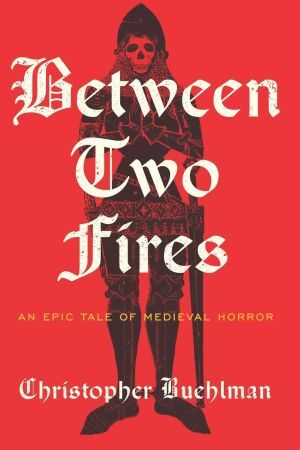 Between Two Fires
Between Two Fires
A gripping historical horror set in France during the Black Plague that is as bleak as it is intense. Buehelman beautifully builds out the hellish world of 1348 Avignon and populates it with empathetic, if not fraught, characters while weaving their journey into a much larger and significantly more epic tale. Angels. Demons. Redemption. Sacrifice. War in heaven and on Earth. I was absorbed from its harrowing beginning to its spectacular ending. I wish I could erase my brain and read it again for the first time— Between Two Fires has become not only my favorite this year but one of my favorites of all time.
 Favorite Novel Runners-up of 2022
Favorite Novel Runners-up of 2022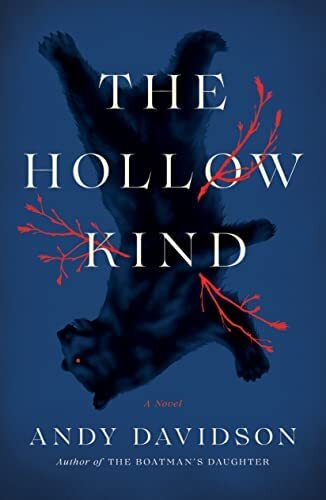 The Hollow Kind
The Hollow Kind
A southern gothic-cum-cosmic horror story that oozes atmosphere and dread with the turn of every page. Brilliantly written, The Hollow Kind weaves two tales of different generations of the Redfern family. Tragedy subsumes the story as each struggle with inner demons and even darker family secrets on their thousand-acre turpentine estate deep in the Georgia pines. A phenomenal book and Davidson’s best work to date.
 The Power Broker: Robert Moses and the Fall of New York
The Power Broker: Robert Moses and the Fall of New York
Arguably one of the most extraordinary biographic explorations into an individual’s life and his incredible impact on the modern city. Moses is a complicated figure. Caro conveys a sprawling saga of a driven man who would stop at nothing to see his vision accomplished, shedding everything along the way, from his friends, family, and values, on a relentless quest for power and control over the city of New York. Gripped me from the outset.
 Honorable Mentions of 2022
Honorable Mentions of 2022It took a lot of internal debate to last on those three. Overall, 2022 was a good reading year for me, and a lot stood out. So out of all that list, here are a few more I think you owe it to yourself to check out:
Nemesis Games by James S. A. CoreyI read one of these a year, and every year, I walk away thinking it’s the best epic sci-fi series I’ve read in a long, long time. This book was one of the best. The Wicked Blade by Jason Vanhee
Beautiful and melancholy Arthurian fantasy told from the perspective of an elderly Morgan le Fay. Rise of the Mages by Scott Drakeford
A violent action fantasy with solid world-building, loads of combat, and a unique magic system. Crossroads by Laurel Hightower
Heartbreaking horror showing how far a mother would go for her child. Shorefall by Robert Jackson Bennett
A phenomenal continuation of Bennett’s Founders Trilogy, it builds on the plot from the first book and expands into a whole new direction. Billy Summers
Stephen King writes an engaging crime thriller about an assassin who is also interested in becoming and novelist. Piranesi by Susanna Clarke
A strange and beautiful fever dream about an endless house and the man who lives within. Dead Silence by S.A. Barnes
Space star-cruise horror—gripping and intense. Working salvage has never been this terrifying. Parable of the Sower by Octavia Butler
A fantastic and bleak post-apocalyptic story that explores faith and the formation therein. The Book of Koli by M. R. Carey
A fascinating look into a post-apocalyptic society faced with ecological terrors. The Gone World by Tom Sweterlitsch
Deep-space-multiverse-time-travel-adventure following a Navy Inspector hunting down a killer across time and the multiverse. Razorblade Tears
A violent and often thriller about a pair of old criminals who team up to avenge their murdered sons.
 Graphic Novels &
Graphic Novels &  Short Stories
Short StoriesBoth comics and short stories played less of a role in my reading this year. As for comics, I’ve started running out of space to store them and switched to reading more digitally, so I hope that changes. With short stories, I find them more unsatisfying these days. It’s more the format than any writing. I always want to spend a little more time with the characters and get to know their world. They all end too soon, and I always feel a little disappointed. Since I didn’t read enough short stories or graphic novels, it’d be unfair to pick top choices. That said, I did enjoy everything on this list.
Preacher: Book Fourby Garth Ennis (Author) & Steve Dillon (Artist) Gideon Falls, Vol. 4: The Pentoculus
by Jeff Lemire (Author) & Andrea Sorrentino (Artist) 86 Volts: The Dead Girl
by Bryan J. L. Glass (Author) & Michael Avon Oeming (Author, Artist) Paper Girls, Vol. 3
by Brian K. Vaughan (Author), Cliff Chiang (Artist) a quarter of an inch
by Bill Bradbury Mayday
by Manu Zolezzi
 Poems
PoemsAh, poetry. How I want to read more of you. I subscribed to the Poetry Foundations’ daily Poem of the Day newsletter list this year, which helped. It’s an excellent and easily digestible way to get a bit of daily poetry in your life. I didn’t record every poem I read, but standouts usually made this list. My goal next year is to double this list—50 poems in 2023. Let’s see how I do next year.
“New Year’s Day”by Kim Addonizio “What Just Came Out of My Head”
by John Dev To _____________
by W. S. Merwin “Fog”
by Carl Sandburg “The Solitude of Night”
by Li Bai “Drink Your Tea”
by Thich Nhat Hanh “Ashglory”
by Paul Celan “Oread”
by H. D. “Selected Legends of Andre the Giant”
by Todd Kaneko “Summer”
by Chen Chen “I want to drown in the past and call it the best decision of my life”
by Laura Marie Marciano “The Lyric In A Time of War”
by Eloise Klein Healy “[I met a man a dying man]”
by Diane Seuss “The Red Wheelbarrow”
by William Carlos Williams “The morns are meeker than they were – (32)”
by Emily Dickinson “How it Escaped Our Attention”
by Heid E. Erdrich “The Witch”
by Elizabeth Willis “Proust’s Madeleine”
by Kenneth Rexroth “Line in the Wordcaves”
by Paul Celan “A Divine Image”
by William Blake “Ghost-ship”
by Christine Garren “Ode I. 11”
by Horace “[little tree]”
by E. E. Cummings
So, that concludes the revisit of my year in the written word. Much more good than bad. Much more enjoyable than not. When it comes to reading, I look back at 2022 with fondness and can’t wait to see what I read in 2023. Here’s to next year. Here’s to more poetry. Here’s to more graphic novels and perhaps even more short stories. Time will tell, stranger things have happened, and there’s much more to read.
How about you? What were the standout books, graphic novels, short stories, or poems you read this year? I’d love to hear about it. Leave a comment and let me know!
Are you looking for a good book? Want to see my reading lists from previous years? Check any of the links below and see what I was reading in the bygone days of yore.
• 2013 • 2014 • 2015 • 2016 • 2017 •• 2018 • 2019 • 2020 • 2021 •
Next year, why not join me? Goodreads does a reading challenge every year, and I am an active participant. First, follow me on Goodreads (leave me a review while you’re there), and once the New Year arrives, participate in the Goodreads Reading Challenge for 2023.

Want to stay in touch with me? Sign up for Dead Drop, my rare and elusive newsletter. Subscribers get news, previews, and notices on my books before anyone else delivered directly to their inbox. I work hard to make sure it’s not spammy and full of interesting and relevant information. SIGN UP TODAY →
December 26, 2022
2022 in Ten Significant Photos
Strangely, this December has felt more harried than the usual holiday hustle and bustle. I can’t exactly put my finger on why. I usually get this post done before Christmas. But life, time, and schedules made assembling this post more difficult than it should have been. But here we are; it’s happening.
This is my annual post wherein I reflect on my last year through ten photos that marked significant places in my year. It’s a tradition here. A lot has happened; looking back, I saw a year with soaring highs and pretty tricky lows. It turns out we’re all figuring out how to reemerge from the pandemic, whether it affected us or not.
The rules. Pick ten photos from my past year that are the most significant to me: positive or negative—significance can be found in either. But it can’t be more; it can’t be less. Some moments will have to fall by the wayside—that’s intentional—culling is a part of this process. It helps create a more realistic and personal picture of the year. Some years will be more complicated than others, and sometimes you’ll need to discover significance in the smaller, quieter moments. This is the way.
Let’s get into it.
 The Smith Tower (Left) – Kari-Lise and our friend
Roxanna Walitzki
(Center) – Kari-Lise with her parents and brother (Right)
The Smith Tower (Left) – Kari-Lise and our friend
Roxanna Walitzki
(Center) – Kari-Lise with her parents and brother (Right)We started the year off strong, celebrating Kari-Lise’s 40th birthday! We threw a big shindig for her by renting out a portion of the Smith Tower Observatory Bar in early January. Friends and family from far and wide came to participate. It was wonderful. The night was foggy, but the vibe was excellent, and after two follow-up after-parties that lasted well into the next morning, I think we all felt like we celebrated Kari-Lise properly.
 Horace, the first day
Horace, the first dayWe said goodbye to Horace. This little lovely buddy had been with us since 2013 (back when Instagram filters were a thing), when he wandered into our yard and our lives. We asked the neighbors and talked to various local vets and pet shops, but no one claimed him. So he stayed with us. Letting him go was hard. He was such a fastidious little fella, the opposite of Willa in many respects, more subdued and less gregarious but always friendly and eager to cuddle. We miss him every day.
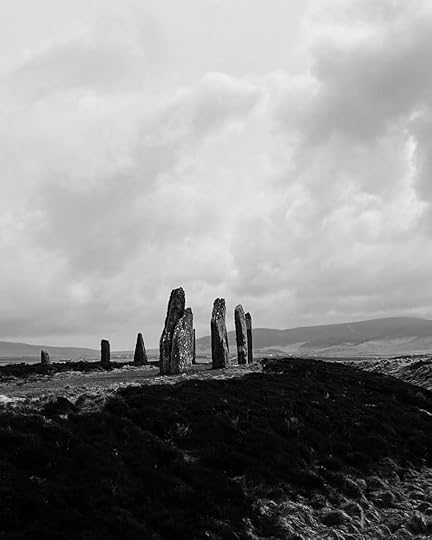 The Ring of Brodgar on the Orkney Island of Mainland
The Ring of Brodgar on the Orkney Island of MainlandWe went back to Scotland! This trip had been intended to be my 40th birthday celebration, but the pandemic delayed things by about a year. Getting away was a welcome relief, and it was great to return to one of my favorite countries on earth. (Honestly, we’d love to move there.) We spent an extended time on Islay, bummed around Edinburgh, tasted over 43 varieties of single-malt scotch, took to the mountains, and explored the Orkney Islands. You can see and read much more about our experience in my Scotland 2022 Trip Report.
 A very happy Victory Sage, photo by her mother, Aischa
A very happy Victory Sage, photo by her mother, AischaThe streak continues; since 2019 at least one new niece has arrived, and 2022 was no different. Not long after our trip to Scotland, my brother Anthony and his wife Aisha welcomed Victory Sage, their third little one, into the world and our lives. I can’t wait to meet her. (More on that later.) Victory is my sixth niece, and I know for a fact there’s another one coming next year. SO. MANY. NIECES.
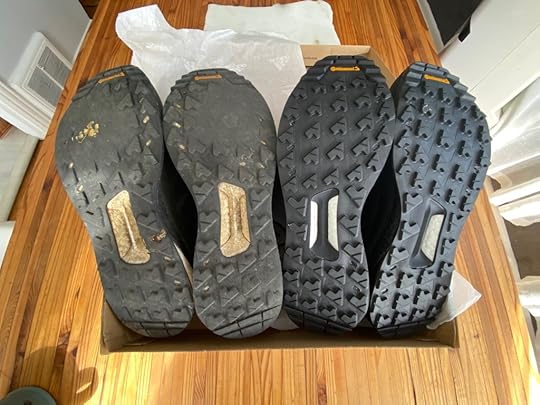 What 500 miles will do to a pair of Adidas Terrex Free Hikers
What 500 miles will do to a pair of Adidas Terrex Free HikersI lost weight. Over 60 pounds now. Around January 3rd, I got tired of how much weight I had gained over the last few years and took control. I started counting my calories and walking, and I walked a lot. All over my neighborhood, hundreds of times, the results slowly but surely began to show. The last time I weighed what I do now was back in 2012, and in the next year, I plan on losing more. Feels good. I wrote about my weight loss journey back in June.
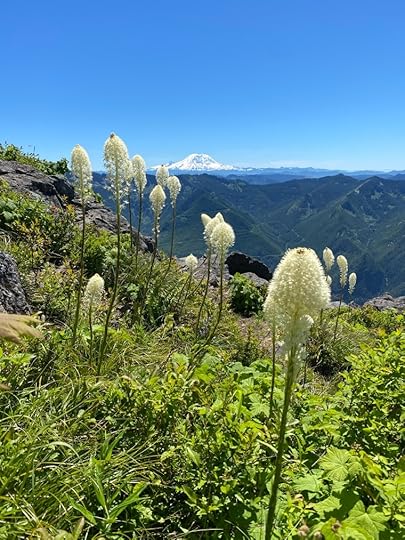 Mt. Rainier viewed from the top of Mailbox Peak
Mt. Rainier viewed from the top of Mailbox PeakI somehow convinced Kari-Lise to hike Mailbox Peak for our 19th Anniversary. It was a stunning hike and a good challenge for a guy who had just lost a bunch of weight. Unfortunately, I slipped and nearly broke my ankle on the way down. The sprain was serious, something I didn’t realize since adrenaline had kicked in and I was still six miles from the trailhead. When I got home and took off my shoes, my ankle swelled three times in size and turned purple. The injury would stay with me for a while, and it took weeks before I was back walking like I was before—a rough way to spend the summer, don’t recommend it.
 A hazy view from Stingeroo ridge
A hazy view from Stingeroo ridgeThis year our good friends Steve and Sarah purchased a big parcel of land in Southern Washington overlooking the town of Longview and the Columbia River. They’ve dubbed it Stingeroo (a portmanteau of their surnames.) We’ve already been down there many times, and it’s a beautiful and relaxing getaway. Steve and I even did a hazy writing retreat down there this October (which is where this photo was taken), and it was the perfect place to reconnect with my writing. Expect to see more from Stingeroo in the future.
 The Moment via the
Seattle Mariners Instagram Account
The Moment via the
Seattle Mariners Instagram Account
Drought ended. This year, for the first time since the year 2000, the Mariners made it into the postseason ending the longest playoff drought in professional sport. I was thrilled. I didn’t become a Seahawks fan until I moved to Seattle, but I was a Mariners fan since I was a kid and followed the team from the Griffy era onward. It was exciting to see them finally make it this far, and I am thrilled for their future.
 Hey, it’s me in the hospital
Hey, it’s me in the hospitalSo yeah. This happened. At the end of October, I watched an old umbilical hernia I once had repaired as a kid return. It’s weird to see your belly button rise from your stomach in real-time and turn purple. The following pain was incredibly intense and debilitating, and Kari-Lise had to rush me to the emergency room. The doctors managed to push it back, relieving me of some pain, but they thought I needed surgery ASAP. It was a hectic two days. Abdominal surgery is no joke. It took a week and a half to feel normal-ish and several more weeks for full recovery, another injury derailing my weight loss momentum. I’m back at it, but it’s been a rough year injury-wise.
 Ice encasing the branches of one of our Japanese maple trees
Ice encasing the branches of one of our Japanese maple treesThis was supposed to be the first year I celebrated Christmas with my family since the pandemic. I was excited. I’d meet my new niece, Victory, for the first time and see my siblings and all my other niblings again. Sadly the weather changed everything. Arctic air from the North Pole pushed down into the states, and freezing rain shut down first Seattle, the airport, and then the passes making travel to my folks impossible for the holidays. It was a bitter end to a challenging year for us, and while we managed to scrape together a celebration of our own, it was tinged with sadness.
So there are my ten significant photos representing some of the bright spots and some of the disappointments of the year. This year was a mixed year for us. Life and work felt harried and unceasing, and the moments of quiet never seemed sufficient.
There was still so much to my 2022 that this post didn’t cover—a cold trip to Victoria with friends to celebrate Steve’s birthday. Island escapes. Walks around the neighborhood with other friends. Writing retreats. Moth & Myths explorations into classes and then doing an incredible installation downtown. A Valentines Day dinner on the 50-yard line of Lumen Field. Returning to the office. Becoming a Godfather. A fantastic visit from my folks. A family trip to Port Angeles. Art openings! Spooky theater shows. Spending time with Kari-Lise’s brother and his family. Backyard BBQs. Baseball and soccer games. So much more, and as with every year, this list could be so much longer.
So, how about you? What did you experience in 2022? What are your ten photos? Assemble them and leave a comment with a link! Let us all know about the significant events in your year.
I’ve been doing this since 2014, and even in challenging years, I’ve found it beneficial. Interested in revisiting my photos of past years? Just click on any link below and check out my selection from that specific year.
• 2014 • 2015 • 2016 • 2017 •• 2018 • 2019 • 2020 • 2021 •

Want to stay in touch with me? Sign up for Dead Drop, my rare and elusive newsletter. Subscribers get news, previews, and notices on my books before anyone else delivered directly to their inbox. I work hard to make sure it’s not spammy and full of interesting and relevant information. Sign Up Today →
December 24, 2022
Old Haunts: Alleyway Holiday
 The Terraces
The Terraces Level Four
Level Four Early-Evening
Early-Evening“I passed under more Auseil branches and banners, and street-level window displays peppered with the Zann hymns of jubilant holiday revelers. As I walked, the lamps mounted in the ceiling above began to dim. Dusk in Lovat.”
—Waldo Bell, Red Litten World
Credits:“Good King Wenceslas” by Godfrey Malcolm & Fredrico (1943)
Other audio and video from original, licensed, and public domain sources.
 This is just one of many.
This is just one of many.You never know what you’ll discover in the twisted streets, quiet alleys, and busy warrens of Lovat. Enjoy these “Old Haunts”, a series of vignettes and visions presented in Glorious Monochrome® by Waite Radio Pictures, Inc.
Radio Pictures, Inc.

Want to stay in touch with me? Sign up for Dead Drop, my rare and elusive newsletter. Subscribers get news, previews, and notices on my books before anyone else delivered directly to their inbox. I work hard to make sure it’s not spammy and full of interesting and relevant information. Sign Up Today →
December 15, 2022
Raunch Review – Beast Wars: Transformers
Raunch Reviews is a series about profanity. Not real profanity, but speculative swearing. Authors often try to incorporate original, innovative forms of profanity into our own fantastical works as a way to expand the worlds we build. Sometimes we’re successful. Often we’re not. In this series, I examine the faux-profanity from various works of sci-fi and fantasy, judge their effectiveness, and rate them on an unscientific and purely subjective scale. This is Raunch Reviews. Welcome.
 The Authors:
Larry DiTillio
&
Bob Forward
Work in Question:
Beast Wars: Transformers
The Profanity: “Slag”
The Authors:
Larry DiTillio
&
Bob Forward
Work in Question:
Beast Wars: Transformers
The Profanity: “Slag”This piece of faux-profanity is interesting, being both very much faux-profanity and very much a real slur—at least if you live in the United Kingdom. But we’re going to skip out on British slut-shaming today and, instead, focus on robots in disguise.
“Slag” is a catchall Transformers profanity first appearing in the original series episode, “Return of Optimus Prime, Part 2,” but later, its use was expanded extensively within the Transformers: Beast Wars sub-franchise, in particular the Beast Wars: Transformers animated series. (Funny enough, I put this together well before the title of the upcoming Transformer film series, Rise of the Beasts, was announced. Kismet, I suppose.)
Now, I realize this is not the only profanity within the Transformers universe, “frag,” “mudflap,” “actuator,” “diode,” and many more machine-specific terms are also used within the franchise and I wouldn’t but surprised if we revisit this universe in the future. That said, “slag” is undoubtedly the most dominant, used by both Maximals and the Predacons throughout the Beast Wars series and spreading broadly in the franchises and sub-franchises that followed. It’s used as an expletive on its own or inserted into phrases such as “what the slag!” “holy slag!” and the ever-popular “I’ll blow your slaggin’ heads off!”
A slaggin’ supercut for your viewing pleasureIt’s easy to see why the mineral by-product of smelting would carry a vulgar connotation on Cybertron. But it’s odd that “slag” becomes the general expletive, especially with other profane words existing and readily available. It fits well within the universe, keeping it interesting, but the overuse holds it back. What we have isn’t a traditional censor slip, but its use within the dialog as that of a one-note go-to replacer is disappointing. This, unfortunately, lessens its impact and turns what could have been a decent instance of faux profanity into more of a joke.
Final Score: 3.0




 Previous Raunch Reviews
“Critch” from René Echevarria & Travis Beacham’s Carnival Row
“Hippikaloric” from L. Frank Baum’s Wizard of Oz (Series)
“Stars and Stones” from Jim Butcher’s Dresden Files
“Karabast” from Simon Kinberg, Dave Filoni, & Carrie Beck’s Star Wars: Rebels
“Pashangwala” from Daniel Abraham, Ty Franck, & Nick Farmer’s The Expanse
“Space!” from Isaac Asimov’s Foundation
“petaQ” from Gene Roddenberry’s Star Trek
“Felgercarb” from Glen A. Larson’s Battlestar Galactica (1978)
“Hood’s [Body Part]” from Steven Erikson’s Malazan Book of the Fallen Series
“Andreste’s Flaming Knickers” from David Gaider & BioWare’s Dragon Age Series
“Fangbanger” from Alan Ball’s True Blood
“Mit’ka” from Brad Wright & Jonathan Glassner’s Stargate SG-1
“Merlin’s Beard” from J. K. Rowling’s Harry Potter series
“Drokk” from John Wagner & Carlos Ezquerra’s Judge Dredd
“Skin Job” from Hampton Fancher & David Peoples’ Blade Runner
“Frag” from J. Michael Straczynski’s Babylon 5
“Gorram” from Joss Whedon’s Firefly
“Prawn” from Neill Blomkamp & Terri Tatchell’s District 9
“By the Firsts” from K. M. Alexander’s Bell Forging Cycle
“Smurf” from Raja Gosnell & Jordan Kerner’s The Smurfs (2011)
“Dren” from Rockne S. O’Bannon’s Farscape
“Quiznak” from J. Dos Santos & L. Montgomery’s Voltron: Legendary Defender
“Smeg” from Rob Grant and Doug Naylor’s Red Dwarf
“Burn Me” from Robert Jordan’s The Wheel of Time
“Slitch” from Robert A. Heinlein’s Friday
“Yarbles” from Anthony Burgess’ A Clockwork Orange
“Cuss” from Wes Anderson’s Fantastic Mr. Fox
“Feth” from Dan Abnett’s Gaunt’s Ghosts from Warhammer 40k
“Shazbot” from Garry Marshall’s Mork & Mindy and Dynamix’s Starsiege: Tribes
“Seven Hells” from George R. R. Martin’s A Song of Ice & Fire/Game of Thrones
“Mudblood” from J. K. Rowling’s Harry Potter series
“Frak” from Glen A. Larson’s, Ronald D. Moore’s, & David Eick’s Battlestar Galactica
“Jabber” from China Miéville’s Bas-Lag series
“Storm it”/”Storms”/”Storming” from Brandon Sanderson’s The Stormlight Archives
Previous Raunch Reviews
“Critch” from René Echevarria & Travis Beacham’s Carnival Row
“Hippikaloric” from L. Frank Baum’s Wizard of Oz (Series)
“Stars and Stones” from Jim Butcher’s Dresden Files
“Karabast” from Simon Kinberg, Dave Filoni, & Carrie Beck’s Star Wars: Rebels
“Pashangwala” from Daniel Abraham, Ty Franck, & Nick Farmer’s The Expanse
“Space!” from Isaac Asimov’s Foundation
“petaQ” from Gene Roddenberry’s Star Trek
“Felgercarb” from Glen A. Larson’s Battlestar Galactica (1978)
“Hood’s [Body Part]” from Steven Erikson’s Malazan Book of the Fallen Series
“Andreste’s Flaming Knickers” from David Gaider & BioWare’s Dragon Age Series
“Fangbanger” from Alan Ball’s True Blood
“Mit’ka” from Brad Wright & Jonathan Glassner’s Stargate SG-1
“Merlin’s Beard” from J. K. Rowling’s Harry Potter series
“Drokk” from John Wagner & Carlos Ezquerra’s Judge Dredd
“Skin Job” from Hampton Fancher & David Peoples’ Blade Runner
“Frag” from J. Michael Straczynski’s Babylon 5
“Gorram” from Joss Whedon’s Firefly
“Prawn” from Neill Blomkamp & Terri Tatchell’s District 9
“By the Firsts” from K. M. Alexander’s Bell Forging Cycle
“Smurf” from Raja Gosnell & Jordan Kerner’s The Smurfs (2011)
“Dren” from Rockne S. O’Bannon’s Farscape
“Quiznak” from J. Dos Santos & L. Montgomery’s Voltron: Legendary Defender
“Smeg” from Rob Grant and Doug Naylor’s Red Dwarf
“Burn Me” from Robert Jordan’s The Wheel of Time
“Slitch” from Robert A. Heinlein’s Friday
“Yarbles” from Anthony Burgess’ A Clockwork Orange
“Cuss” from Wes Anderson’s Fantastic Mr. Fox
“Feth” from Dan Abnett’s Gaunt’s Ghosts from Warhammer 40k
“Shazbot” from Garry Marshall’s Mork & Mindy and Dynamix’s Starsiege: Tribes
“Seven Hells” from George R. R. Martin’s A Song of Ice & Fire/Game of Thrones
“Mudblood” from J. K. Rowling’s Harry Potter series
“Frak” from Glen A. Larson’s, Ronald D. Moore’s, & David Eick’s Battlestar Galactica
“Jabber” from China Miéville’s Bas-Lag series
“Storm it”/”Storms”/”Storming” from Brandon Sanderson’s The Stormlight Archives
Have a suggestion for Raunch Reviews? It can be any made-up slang word from a book, television show, or movie. You can email me directly with your recommendation or leave a comment below. I’ll need to spend time with the property before I’ll feel confident reviewing it, so give me a little time. I have a lot of books to read.

December 10, 2022
Stay Drunk
“You must stay drunk on writing so reality cannot destroy you.”
Ray Bradbury
November 14, 2022
Raunch Review: Carnival Row
Raunch Reviews is a series about profanity. Not real profanity, but speculative swearing. Authors often try to incorporate original, innovative forms of profanity into our own fantastical works as a way to expand the worlds we build. Sometimes we’re successful. Often we’re not. In this series, I examine the faux-profanity from various works of sci-fi and fantasy, judge their effectiveness, and rate them on an unscientific and purely subjective scale. This is Raunch Reviews. Welcome.
 The Author:
René Echevarria
,
Travis Beacham
Work in Question:
Carnival Row
The Profanity: “Critch”
The Author:
René Echevarria
,
Travis Beacham
Work in Question:
Carnival Row
The Profanity: “Critch”In the world of Burgue from Amazon’s fantasy-fueled steampunk fairytale Carnival Row, humans live alongside mythical creatures who have fled their war-torn homeland. As you expect with any setting featuring this sort of mass immigration of refugees, there are examinations of xenophobia, bigotry, classism, and segregation. Most humans dislike these newcomers, and throughout the series, the viewer witnesses it from a variety of perspectives that of the commoner, law enforcement, and the elite.
As you’d expect, this plays out often in language, particularly with the word “critch.” Like any language designed to dehumanize, “critch” is the catchall term for any non-human species. It’s derived from “creature” and wielded with a particular venom by the various bullies throughout the series.
This is an interesting slur, focusing more on a class of people rather than a particular species. However, those species-specific insults are also in Carnival Row’s world as well: “Puck” being faun-specific, “Pix” for the Faerie, “Brute” for the Trow, and so on. And in many ways, these work better because they focus on each species rather than a random group. So “critch” exists in an odd space, clearly meant to harm and degrade, but it’s also so broad it loses some of the edge, which would make a slur like this so pernicious. Falls a little flat under scrutiny.
Final Score: 3.5




 Previous Raunch Reviews
“Hippikaloric” from L. Frank Baum’s Wizard of Oz (Series)
“Stars and Stones” from Jim Butcher’s Dresden Files
“Karabast” from Simon Kinberg, Dave Filoni, & Carrie Beck Star Wars: Rebels
“Pashangwala” from Daniel Abraham, Ty Franck, & Nick Farmer’s The Expanse
“Space!” from Isaac Asimov’s Foundation
“petaQ” from Gene Roddenberry’s Star Trek
“Felgercarb” from Glen A. Larson’s Battlestar Galactica (1978)
“Hood’s [Body Part]” from Steven Erikson’s Malazan Book of the Fallen Series
“Andreste’s Flaming Knickers” from David Gaider & BioWare’s Dragon Age Series
“Fangbanger” from Alan Ball’s True Blood
“Mit’ka” from Brad Wright & Jonathan Glassner’s Stargate SG-1
“Merlin’s Beard” from J. K. Rowling’s Harry Potter series
“Drokk” from John Wagner & Carlos Ezquerra’s Judge Dredd
“Skin Job” from Hampton Fancher & David Peoples’ Blade Runner
“Frag” from J. Michael Straczynski’s Babylon 5
“Gorram” from Joss Whedon’s Firefly
“Prawn” from Neill Blomkamp & Terri Tatchell’s District 9
“By the Firsts” from K. M. Alexander’s Bell Forging Cycle
“Smurf” from Raja Gosnell & Jordan Kerner’s The Smurfs (2011)
“Dren” from Rockne S. O’Bannon’s Farscape
“Quiznak” from J. Dos Santos & L. Montgomery’s Voltron: Legendary Defender
“Smeg” from Rob Grant and Doug Naylor’s Red Dwarf
“Burn Me” from Robert Jordan’s The Wheel of Time
“Slitch” from Robert A. Heinlein’s Friday
“Yarbles” from Anthony Burgess’ A Clockwork Orange
“Cuss” from Wes Anderson’s Fantastic Mr. Fox
“Feth” from Dan Abnett’s Gaunt’s Ghosts from Warhammer 40k
“Shazbot” from Garry Marshall’s Mork & Mindy and Dynamix’s Starsiege: Tribes
“Seven Hells” from George R. R. Martin’s A Song of Ice & Fire/Game of Thrones
“Mudblood” from J. K. Rowling’s Harry Potter series
“Frak” from Glen A. Larson’s, Ronald D. Moore’s, & David Eick’s Battlestar Galactica
“Jabber” from China Miéville’s Bas-Lag series
“Storm it”/”Storms”/”Storming” from Brandon Sanderson’s The Stormlight Archives
Previous Raunch Reviews
“Hippikaloric” from L. Frank Baum’s Wizard of Oz (Series)
“Stars and Stones” from Jim Butcher’s Dresden Files
“Karabast” from Simon Kinberg, Dave Filoni, & Carrie Beck Star Wars: Rebels
“Pashangwala” from Daniel Abraham, Ty Franck, & Nick Farmer’s The Expanse
“Space!” from Isaac Asimov’s Foundation
“petaQ” from Gene Roddenberry’s Star Trek
“Felgercarb” from Glen A. Larson’s Battlestar Galactica (1978)
“Hood’s [Body Part]” from Steven Erikson’s Malazan Book of the Fallen Series
“Andreste’s Flaming Knickers” from David Gaider & BioWare’s Dragon Age Series
“Fangbanger” from Alan Ball’s True Blood
“Mit’ka” from Brad Wright & Jonathan Glassner’s Stargate SG-1
“Merlin’s Beard” from J. K. Rowling’s Harry Potter series
“Drokk” from John Wagner & Carlos Ezquerra’s Judge Dredd
“Skin Job” from Hampton Fancher & David Peoples’ Blade Runner
“Frag” from J. Michael Straczynski’s Babylon 5
“Gorram” from Joss Whedon’s Firefly
“Prawn” from Neill Blomkamp & Terri Tatchell’s District 9
“By the Firsts” from K. M. Alexander’s Bell Forging Cycle
“Smurf” from Raja Gosnell & Jordan Kerner’s The Smurfs (2011)
“Dren” from Rockne S. O’Bannon’s Farscape
“Quiznak” from J. Dos Santos & L. Montgomery’s Voltron: Legendary Defender
“Smeg” from Rob Grant and Doug Naylor’s Red Dwarf
“Burn Me” from Robert Jordan’s The Wheel of Time
“Slitch” from Robert A. Heinlein’s Friday
“Yarbles” from Anthony Burgess’ A Clockwork Orange
“Cuss” from Wes Anderson’s Fantastic Mr. Fox
“Feth” from Dan Abnett’s Gaunt’s Ghosts from Warhammer 40k
“Shazbot” from Garry Marshall’s Mork & Mindy and Dynamix’s Starsiege: Tribes
“Seven Hells” from George R. R. Martin’s A Song of Ice & Fire/Game of Thrones
“Mudblood” from J. K. Rowling’s Harry Potter series
“Frak” from Glen A. Larson’s, Ronald D. Moore’s, & David Eick’s Battlestar Galactica
“Jabber” from China Miéville’s Bas-Lag series
“Storm it”/”Storms”/”Storming” from Brandon Sanderson’s The Stormlight Archives
Have a suggestion for Raunch Reviews? It can be any made-up slang word from a book, television show, or movie. You can email me directly with your recommendation or leave a comment below. I’ll need to spend time with the property before I’ll feel confident reviewing it, so give me a little time. I have a lot of books to read.

November 11, 2022
Open Call for 2022 Cosmic Horror Items
Oh, you know it’s coming back.
Every year since 2014, I have assembled a holiday gift guide focused on cosmic-horror goodies. It’s become one of my favorite annual projects. Our little corner of the horror world is full of talented creators, and I like to use the gift guide to highlight some of the fabulous weird-fiction-related items I’ve discovered throughout the year. 2022 will be no different. (I’ll link to previous guides below so you can see what I’ve featured previously.)
That said, I am but one man, and there’s always cool stuff out there I missed. I could use your help. As I have for the last several years, I’m getting an early jump on assembling the guide. And it’s always worthwhile to do an open call and see what else lurks in the internet’s shadowed corners. This is that open call! Link me cool stuff! What have you found, dear reader? I want to know about it, and I’m sure others do too.
As always, the categories are:
Books (I generally have this covered)MusicApparel (no teeshirts—there’s a bajillion of them)GamesHousewaresMiskatonic UniversityYou can leave a comment below (I approve all non-bot comments), tweet me, or drop me an email. Let me know what you’ve found that would be perfect for this year’s Gift Guide! Not everything submitted will be featured. I curate the heck out of this.
Thanks in advance!
Previous Cosmic Horror Gift GuidesAs promised, below are links to the guides from the last seven years. Some of the products were one-offs, are out of print, or just aren’t sold anymore. Don’t be shocked if you find broken links, especially in those earlier guides. It happens. Still, loads of cool stuff to check out.
 2021
–
2020
–
2019
–
2018
–
2017
–
2016
–
2015
–
2014
2021
–
2020
–
2019
–
2018
–
2017
–
2016
–
2015
–
2014

The annual 2022 Cosmic Horror Holiday Gift Guide arrives on Black Friday, the darkest and most vile winter “holiday.” Return here in a few weeks to see this year’s thematic selection. Tell your friends! Share with your family! Shout it from the rooftops! It’s going to be a good one. 
November 10, 2022
Ishikawa: A Free 17th Century Brush Set for Fantasy Maps
Sourcing high-quality images to extract brush sets can be an arduous process, especially if you’re looking for something fresh and unique. There are hundreds of resources out there, but most are limited to western sources and skew more European. (Especially the prolific Dutch.) This is fine, but for a while, I’ve really wanted to diversify my brush sets and bring in more varied approaches and artistic voices.
So, when I recently came across a 17th-century map from Ishikawa Ryūsen (or Tomonobu), I got excited. Ishikawa Ryūsen was a Japanese writer, ukiyo-e painter, and cartographer from the late seventeenth and early eighteenth century who primarily worked for the Edo-period shogunate. His work became the foundation of Ryūsen-zu, a style of woodblock map prints, and because of their artistic value, were often printed on folding screens. His maps have been reprinted many times, so I found it a little surprising that it took me so long to come across his work. But the version I found was perfect for a brush set, and after pouring over it for hours, I knew with a little work, it would be the perfect source for my first non-European brush set.
Today, I am happy to announce the release of Ishikawa, an extensive cartography brush set extracted from 日本海山潮陸圖 (Map of Sea, Mountain, Tide, and Land of Japan) depicting the Japanese islands of Honshū, Shikoku, and Kyūshu during the Edo period. It’s a stunning set with loads to offer, and it will help create maps that stand apart from the traditional European-influenced fantasy maps.
 A sample of the settlement brushes you’ll find in Ishikawa
A sample of the settlement brushes you’ll find in IshikawaThere are some obvious stylistic differences here. From the almost kanji-inspired flora to the elegant, calligraphic mountains, but it’s also familiar. For the most part, this is a hill-profile style of map. Some exceptions come in the form of settlement markers, and those skew graphical—the large circles represented jitō manor houses, squares were fortified towns, ovals were traveling stops, and small circles were outposts. Yet, even with these graphical representations, Ishikawa still drew the roofs of the homes and shops that surrounded these points of interest. What we end up with is a fascinating hybrid style, not exactly hill-profile and yet not fully “modern.”
I want to extend a huge thank you to Dr. Amy Bliss Marshall for her help with translation and for providing some deeper dives into the koku-fueled Edo-period Shogunate. Her effort helped significantly in the creation of this set.
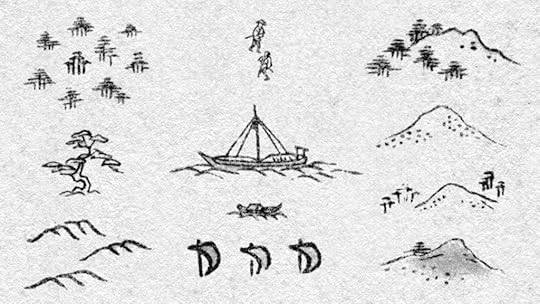 More of Ishikawa’s brush offerings
More of Ishikawa’s brush offeringsSince this is my first Asian-sourced map set, I wanted to make a splash. Ishikawa is enormous. Over 700 unique brushes fill out the set, making this my third largest. (Only Vischer and Ogilby are larger.) While it took more time, I went ahead and removed the kanji from all the simple settlement markers allowing you to use them as you wish.
Inside Ishikawa you’ll find…
23 Cities30 Individual Roofs50 Grouped Roofs27 Individual Buildings25 Blank Outpost Markers (Small Circles)15 Blank Travel Stop Markers (Ovals)25 Blank Jitō Manor Markers (Large Circles)15 Blank Fortified Town Markers (Squares)5 Blank Named Manor Markers (Larger Squares)5 Blank Region Markers (Tall Rectangles)43 Torri Gates15 Unique Settlement Markers100 Individual Trees100 Forests (Grouped Trees)3 Unique Flora Markers71 Individual Mountains67 Grouped Mountains73 Waves2 People Cartouches (Sword Fight!)4 Directional Cartouches18 Small Boat Cartouches21 Large Boat Cartouches15 Sail Cartouches (These could also work as banners, just sayin’)1 Group of Boats Cartouche[ BONUS!] 7 Directional Road/Border/Line Brushes
BONUS!] 7 Directional Road/Border/Line BrushesI’m excited about Ishikawa’s bonus brushes. They are something many people have been asking for, and I’m pleased to finally be releasing them. Yep, directional “road” brushes. They’re a bit finicky, and I recommend taking your time with them, but they’ll allow you to easily paint roads and borders that follow the styles from the 17th and 18th centuries. I’ll most likely expand them into their own more fleshed-out set in the future, perhaps even combining them with Ende, my Littoral Edger brushes, but for now, they get to be an Ishikawa bonus.
The button below links to a ZIP file that contains a Photoshop brush set (it’ll also work with GIMP and Affinity Photo) as well as three large transparent PNGs, Settlements (5.3 Mb), Flora & Landforms (3 Mb), and Water Features & Cartouches (2.5 Mb), in case you’re using a program that doesn’t support Adobe brush files. They’re black, and on a transparent background, so they’ll look broken in some browsers, but trust me, they’re all there. (If you want to throw a few bucks my way to help with hosting this stuff, I wouldn’t complain.)
DOWNLOAD ISHIKAWAAs with all of my previous brush sets, Ishikawa is free for any use. I distribute my sets with a Creative Common, No Rights Reserved License (CC0), which means you can freely use this and any of my brushes in commercial work and distribute adaptations. (Details on this decision here.) No attribution is required. Easy peasy!
Enjoy Ishikawa? Feel free to show me what you created by emailing me or finding me on Twitter. I love seeing how these brushes get used, and I’d be happy to share your work with my readers. Let me see what you make!
Ishikawa in UseWant to see how I’ve used this set? You can see the results below. It’s a bit of a blend of styles, but I am happy with how it turned out. There’s a lot you can do with these brushes. There are three versions, a colored, black and white, and a decorated sample. Click on any of the images below to view them larger. Perhaps this will inspire you as you get started on your projects! Feel free to use these for whatever you want. Your next book? A D&D campaign? Lots of possibilities.
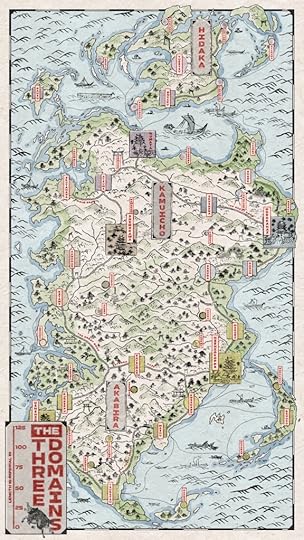 2813×5000 (8MB)
2813×5000 (8MB)
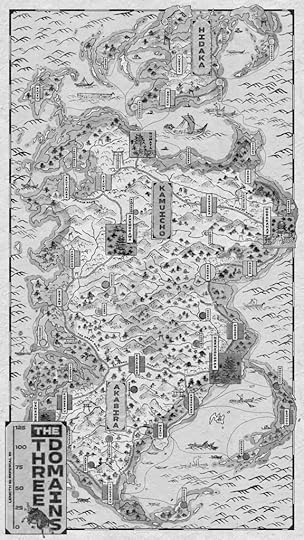 2813×5000 (6.9 MB)
2813×5000 (6.9 MB)
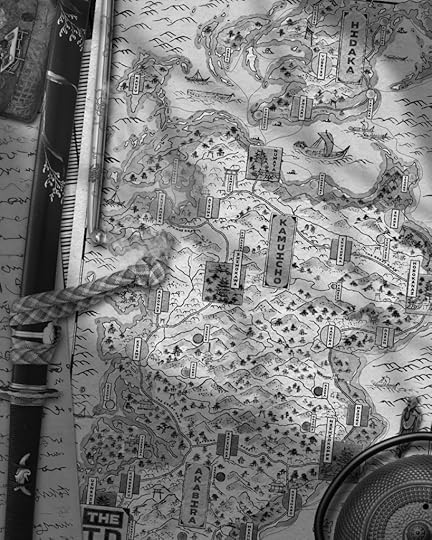 1080×1350 (1.1 MB)
1080×1350 (1.1 MB)Sample Details: Location names were taken from various places and points of interest on Hokkaido. The font I used is a modified version of Bizmo, which was licensed from Envato Elements. I do not recommend laying this many western characters vertically, but I wanted to evoke some of the elements from Ishikawa’s original source and decided I was okay with it being a little illegible. The paper texture is from True Grit Texture Supply’s Infinite Pulp, and they’re also where I got Atomica, which gives me ink-like effects for the text—big fan of their tools. The boar illustration in the key is from an 1857 woodblock print by Utagawa Yoshitora and is available for free on Deviant Art.
Support this WorkIf you like the Ishikawa brush set (or any of my free brushes, really) and want to support my work or just help cover the cost of hosting, consider buying one of my cosmic-horror-soaked dark urban fantasy novels. The first book—The Stars Were Right—is only $2.99 on eBook. I think you’ll dig it. You can find all my books in stores and online. They make great gifts. Visit the Bell Forging Cycle hub to learn more about the series. Tell your friends!
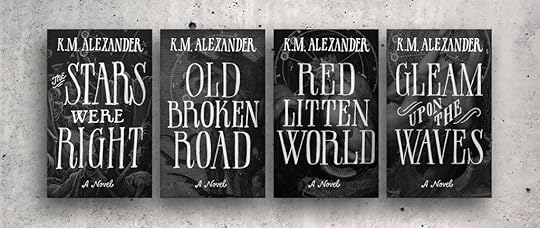 The Bell Forging CycleBuy me a coffee?
The Bell Forging CycleBuy me a coffee?Not interested in my books but still want a way to support the #NoBadMaps project or help pay for hosting these brushes? Why not buy me a coffee?
More Map BrushesIshikawa is just one of many brush sets I’ve released over the years. You can find it and other free brushes covering various historical styles on my Fantasy Map Brushes page. Every set is free, distributed under a CC0 license, and open for personal or commercial use. I’m sure you’ll be able to find something that works for your project. Click the button below to check them out!
view more Fantasy Map Brushes
Want to stay in touch with me? Sign up for Dead Drop, my rare and elusive newsletter. Subscribers get news, previews, and notices on my books before anyone else delivered directly to their inbox. I work hard to make sure it’s not spammy and full of interesting and relevant information. Sign Up Today →
November 8, 2022
Vote, America. Vote. 🗳
I usually like to release brush sets on Tuesdays. It’s a habit born from years of working on marketing emails. I had a set all ready for today, but I am pushing it out a bit because here in the United States, we have an election, and it’s an important midterm election. That means if you’re a citizen here in the United States of America, you should go vote.
 My ballot is in and will be counted. Even got a text alert telling me everything was verified.
My ballot is in and will be counted. Even got a text alert telling me everything was verified.We’re vote-by-mail here in Washington State, and I turned my ballot in last week, and it was verified and counted (or will be counted tonight after the polls close.) If your state doesn’t offer that sort of convenience (I’m sorry) and if you need to know where to go, you can find your polling place here. If you’re an adult US citizen, remember, no one can keep you from voting. Stay in line. Get counted. If you’re intimidated at polls or have problems voting, keep these numbers handy:
866-Our-Vote (English)866-Ve-Y-Vota (Spanish)866-API-Vote (Asian Languages)Find out more information at 866ourvote.org. You got this.
I saw a quote going around on various social media sites for the last few months, and it’s stuck in my head. To paraphrase, it suggested, “If you didn’t know how to vote, think of the most vulnerable individuals you know and vote in their best interests.” That resonated with me, and in turn, reminded me of this poem which is one I’ve been reflecting upon, maybe you’ll also find it inspiring.
Voting As Fire ExtinguisherWhen a haunted house catches fire:
a moment of indecision.
The house was, after all, built on bones,
and blood and bad intentions.
Everyone who enters the house feels
that overwhelming dread, the evil
that perhaps only fire can purge.
It’s tempting to just let it burn.
And then I remember:
there are children inside.

October 4, 2022
The Rings of Power Doesn’t Understand How River Navigation Works
 NOTE: The following contains spoilers for Amazon’s The Rings of Power, especially Episode 6, but really the whole show. So, consider yourself warned.
NOTE: The following contains spoilers for Amazon’s The Rings of Power, especially Episode 6, but really the whole show. So, consider yourself warned.
This isn’t a review of The Rings of Power. Suffice to say, I’ve had a good time with what I’ve seen overall, and I’d recommend it to Tolkien fans and non-Tolkien fans alike. You can see its enormous budget at work; overall, it’s fun. But, an incident in Udûn, Episode Six of The Rings of Power, annoyed me. It was a moment that echoed from previous fantasy shows, namely the last few seasons of Game of Thrones. And I wanted to discuss how dismissing realism (yes, even in fantasy) can dampen dramatic moments.
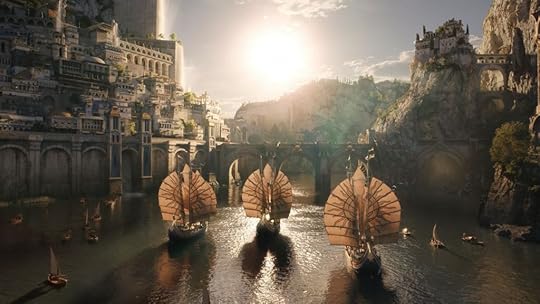 The ships of Númenor – The Lord of the Rings: The Rings of Power – Amazon Prime
The ships of Númenor – The Lord of the Rings: The Rings of Power – Amazon PrimeThe incident in question: the Fast Travel of the Númenorians. “Fast Travel” is a phrase borrowed from video games that allow players to warp around the game world. It’s most recently been applied to movies and television series when characters seem to travel great distances very quickly, all for dramatic effect. Those moments have to be earned. A foundation needs to be built. A reader’s suspension of disbelief disappears when the Deus Ex Machina is fully displayed. We see the man behind the curtain, taking the fun away from the fantasy. And it happened in The Rings of Power.
The scene that kicked off this error was easy to overlook. It was a shot of the Middle Earth map, primarily focusing on the river Anduin with a conversation between Elendil reporting their situation and strategy to Queen Regent Míriel. It goes as follows:
Elendil: “Land has been sighted, your majesty.”
Míriel: “How long til we make anchor?”
Elendil: “It’s a full day’s sail into the mountains, and from there, another day’s ride east, into the vale.”
(Emphasis mine.)
In the prose, Tolkien was always hand-wavy with Middle Earth distance (as the crow flies, a day’s ride, etc.), but I don’t buy that it’s “a full day’s sail” up the Anduin from the Bay of Belfalas. It’s easy to say, but it’s just not realistic. This is a fantasy setting, but magic isn’t being used. They’re traveling in big cumbersome sailing ships. This isn’t a car trip on well-paved roads. These Númenorians are voyaging into the unknown, a place they’ve only read on maps or heard about in stories. The two people with them who are familiar with the area (Galadriel and Halbrand) aren’t sailors.
In The Atlas of Middle Earth, Karen Wynn Fonstad estimates the Anduin is about 1388 miles long. Elendil taps the map in roughly the spot where Minas Morgul ends up being built. [1] Being generous, we’re looking at the distance from the mouth of the delta to the anchorage where they’ll disembark and ride to the vale’s rescue at nearly 300 miles. (The official map for The Rings of Power has a scale and would agree with me—it’s 90-ish leagues which comes out to 280-ish miles.) Rivers on old maps never precisely render a river’s actual meandering, so the odds would be good that, realistically, it was quite a bit longer. Still, we’ll pretend it’s accurate for this discussion and use this guesstimate for our base distance number.
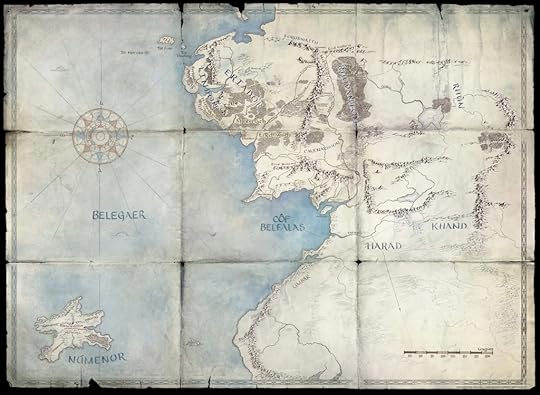 The lands of Númenor and Middle Earth – The Lord of the Rings: The Rings of Power – Amazon Prime
The lands of Númenor and Middle Earth – The Lord of the Rings: The Rings of Power – Amazon PrimeOkay, so we’ve established the Númenorians have to travel 300 miles. Fast sailing frigates during the Age of Sail—technologically, a later time than Middle Earth’s 2nd Age—topped out around 14-ish knots or 16-ish mph on the open sea. Earlier, Roman vessels that sailed the Mediterranean traveled at about 5-ish knots or about 6-ish mph. The Númenorian ships are neither 18th-century frigates nor a Roman 8th-century trireme. They have weird but cool-looking sail structures and seem much bigger than either of our examples. But, for the sake of argument, we’ll be charitable and say they have a speed of 14 knots—these are people of the sea, after all, and they build fine vessels.
So, that’s 300 miles at a generous 16mph. With some quick math, we can see that it’s almost 19 hours from start to finish if you can maintain that speed for the journey. At first, that makes Elendil’s calculation sound reasonable—and this entire essay worthless. We traveled less than a day with time to spare! But there’s a catch, actually a lot of catches. You know what, let’s call them snags.
Snag One:Sailing up river is challenging. Yes, even on a river as wide as the Anduin would be at this point. The top speed for frigates I mentioned above is with good winds, and rivers aren’t known for favorable wind conditions for sailing vessels. Winds tend to follow river valleys flowing with the river to the sea, and even with fore-and-aft rigging (which the Númenorians don’t use, their ships are closer to square-rigging), you’d need constant tacking or jibing to make it up the river. Then there’s the whole other matter of winds shifting.
Snag Two:You’re fighting the current, which slows you down. The flow for that stretch of the Anduin has to be enormous. It’s the primary drainage basin for the Grey Mountains, the Misty Mountains, the Ered Nimrais, and parts of Ephel Dúath. That’s an incredible amount of water. There’s a reason early American settlers used tows to drag boats upriver.
Snag Three:We haven’t even accounted for basic river navigation on top of everything else. Rivers aren’t the open ocean. To seamen like the Númenorians, the Anduin is a ribbon of an ever-changing shore. It is much more complex to navigate than the sea, with prevalent snags, sandbars, bends, and channel depth changes. Heavy seagoing vessels (especially big ones) require much more draw than smaller vessels designed for rivers, so the dangers from all of those hazards would increase the risk and further slow progress.
Snag Four:And then there’s the Anduin’s hydrography. The river flows through flat flood plains, which means its constantly moving. There’s no system in place to “tame” the river. Elves aren’t running snag boats or building weirs and levees. A bend one day could be a dry bed the next because of a snag upstream. This can depend on weather and seasons and the geography of the landscape through which it flows. It’s less of a concern than the other snags, but it is still a snag we should consider.
To the casual viewer, this probably went unnoticed. But for river nerds like me, it was a glaring mistake that sucked some of the fun out of the story. The idea of three enormous sailing vessels making it three hundred miles in a single day grows more unbelievable the more you examine it. But, it was necessary for the plot and therefore explained away. As a result, the Southlander’s rescue felt contrived—it wasn’t earned.
As I mentioned earlier, Game of Thrones did similar things in later seasons and had a similar effect. Euron Greyoy travels from King’s Landing to Casterly Rock so fast he had to set land-speed records. Gendry’s quick “run” back to the Wall. Daenerys flies from Dragonstone beyond the Wall in a few hours. Theon and Sansa escape Winterfell and magically show up on the Iron Islands with hardly a mention of the hundreds of miles of travel between those two locations.
And like Game of Thrones, The Rings of Power writers could have quickly solved this was some minor editing or a few throwaway lines. It doesn’t take much to earn the difficulty of travel. A few lines about how the journey across the sea from Númenor was long and arduous (it was almost 2000 miles according to the official map!) If they wanted to go further, they could have added a few shots of the ships moving upriver, perhaps under oars or being towed from the shore or by rowboats. A quick pan showing the day or two it’d take to unload a cavalry battalion from sailing vessels (something I didn’t even get into) could have added to the tension of the Númenorians not making it in time. Instead, it was brushed aside with an “it’ll take a day and then another day, NABD” as if this journey was simple.
Compare this to the ignition of Mt. Doom at the end of Episode Six. In previous episodes, pieces were placed to set up for that incredible moment. It was earned. We saw the channels being dug by the orcs and the enslaved elves. Characters even asked “why,” drawing our attention to the orc’s strange strategy. Unlike the rescue, the ignition was earned, and it was spectacular.
The rescue fell flat. When you step back, it becomes too convenient to work out the way it did, especially in Tolkien, where travel and the vastness of the land play a big part in the overall plot. It was such a tiny bit, but it developed in ways over the episode that detracted from what could have been an incredible and dramatic scene. Unearned, it came across less like the heroic task it was meant to be and more like watching someone move a few pieces around on a game board, and that’s not nearly as exciting.
[1] Interestingly enough, in Tolkien’s The Return of the King, about two-thirds to half of this same trip is taken up the Anduin by Aragorn and pals after they captured a fleet of ships from the Corsairs of Umbar at the port of Pelargir. These are then rowed (accurate!) upriver over the next exhausting day and a half. And, unlike the Númenorians, Aragorn had an angry ghost army with him, who I assumed greatly helped with the rowing.



